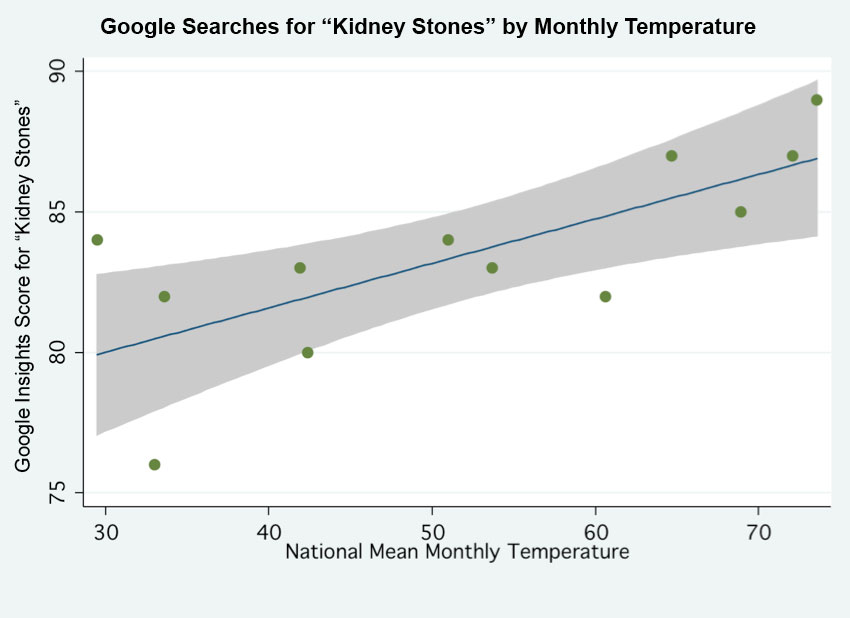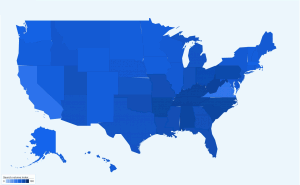
Internet search data can now reveal where and when kidney stones are presenting in almost real time. In the past, gathering information on how often medical conditions (like kidney stones) occur required the meticulous gathering of information from medical records, hospital discharge information, and patient questionnaires. This process was often slow, sometimes expensive, and usually still only covered a small part of the entire population.
Now however, the Google search which probably brought you to this website offers another, potentially better alternative for monitoring kidney stone disease. Because Google and other Internet search providers closely track where and when all searches are performed, every search for a term such as “kidney stones” becomes a potential self-report by a kidney stone patient of their condition and a data point for researchers to examine. In 2009, 74% of American adults used the Internet and 61% looked online for health information. Soon, it is likely that almost all patients will look first to the Internet to learn about their condition which will this type of data even more complete.

Search volume for the term "kidney stones", reflecting higher frequency of stone disease in the Southeastern United States. Credit: Google Insights for Search
We recently used the Google Insights for Search tool to compare searches performed for the most popular term for kidney stone disease, “kidney stones”, in the United States. Insights for Search is a free tool, available through Google, which allows anyone to look at how often or where a specific search term is being submitted. Search volume for “kidney stones” was compared against temperature and geographic data which are known to affect the occurrence of stone disease. As seen in the figure above, search volume increased consistently with national monthly temperature, reflecting the increase in stone development seen during the warmer months. Kidney stone search volume also tracked with latitude and by state, with states known to have higher rates of kidney stone disease showing more search volume. While much of this data mirrored previously collected information obtained using traditional methods, the data from the Google Insights tool has the advantage of providing up-to-date data on a nearly real-time daily basis with complete coverage of the entire world: essentially wherever the Internet is available.
Other researchers have successfully used the Insights tool to track other medical conditions such as flu outbreaks. Because data from Google Insights is available for search volume by time and by geographic location, the tool seems most useful for conditions or topics that vary with time or location. The tool is free for anyone to experiment with at the Google Insights for Search website. Some terms you might try putting in are “fireworks” or “ice cream” to see how a search term can vary by month of the year.
There are important limitations of using the Google Insights for Search tool to track medical conditions. For example, it is not possible with the data provided by Google to determine whether a search was initiated by a patient, a friend or family of a patient, or a student performing a search for an upcoming term paper. It is also not possible to determine whether searches have been prompted by a new development of a kidney stone or from former stone former interested in avoiding a repeat stone episode.
Tools such as Google Insights for Search may become even more powerful in the future if Google (or Facebook) grant researchers access to the additional wealth of demographic information they already collect on us or our activities on the web (age, gender, etc.). Privacy advocates beware.
References
Pew Internet & American Life Project, “The Social Life of Health Information”. 2009
Willard and Nguyen, “Internet Search Trends Analysis Tools Can Provide Real Time Data on Kidney Stone Disease in the United States”. Pending publication in Urology, 2011 and to be presented at the American Urological Association Meeting, May 2011.
Interesting that states in the higher latitude seem to be searching more for stone info. Research from Holick’s New England Journal of Medicine article (vitamindhealth.org) cites findings that people living above the latitude of Atlanta, GA, are more likely to be Vit D deficienct than those living below because Vit D can only be made in the skin for a couple of months of the year at that latitude. Vit D is a major player in turning on our immune systems. For people who get UTIs, THEN stones, maybe go to the drugstore and pick up some cheap Vit D3 to get Vit D levels up to at least 50. I take 4000 iu/day now in order to sustain a level over 50. Also, Vit D gets trapped in body fat (it is a fat-soluable prohormone) so these folks need a higher dose, as do folks with more pigment to their skin. Ever wonder why blacks have higher incidence of cancer in the northeast states? Vitamin D deficiency is the likely culprit. The old level of 30 has been proven woefully too low. Also, see http://www.grassrootshealth.org, coalition of top medical researchers promoting Vit D info to general public to avoid what they consider pandemic of Vit D deficiency (cancer, diabetes, etc) and its repercussions on health. I am an example of the kidney stone/UTI repercussion.